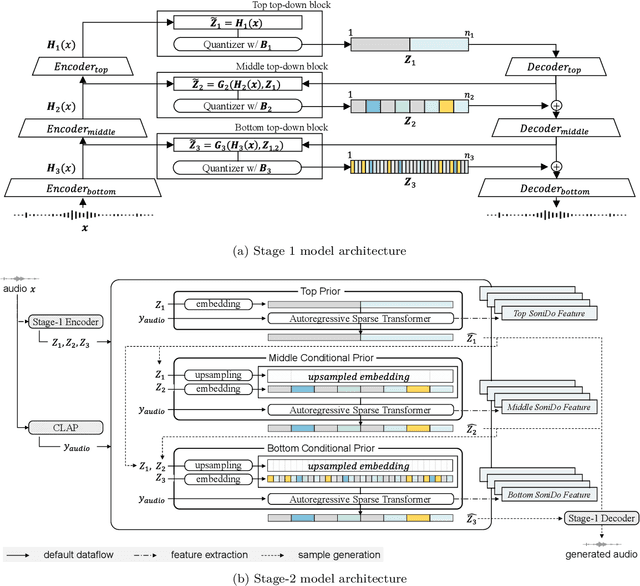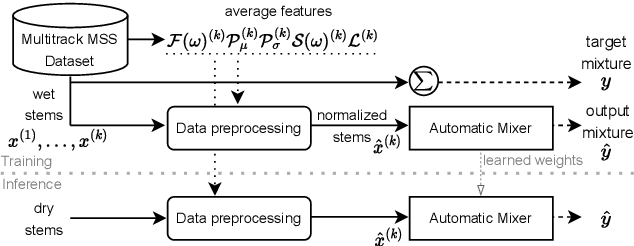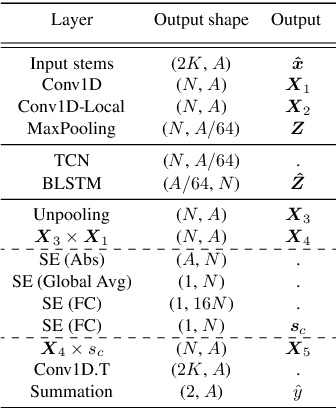Marco A. Martínez-Ramírez
Music Foundation Model as Generic Booster for Music Downstream Tasks
Nov 05, 2024



Abstract:We demonstrate the efficacy of using intermediate representations from a single foundation model to enhance various music downstream tasks. We introduce SoniDo, a music foundation model (MFM) designed to extract hierarchical features from target music samples. By leveraging hierarchical intermediate features, SoniDo constrains the information granularity, leading to improved performance across various downstream tasks including both understanding and generative tasks. We specifically evaluated this approach on representative tasks such as music tagging, music transcription, music source separation, and music mixing. Our results reveal that the features extracted from foundation models provide valuable enhancements in training downstream task models. This highlights the capability of using features extracted from music foundation models as a booster for downstream tasks. Our approach not only benefits existing task-specific models but also supports music downstream tasks constrained by data scarcity. This paves the way for more effective and accessible music processing solutions.
VRVQ: Variable Bitrate Residual Vector Quantization for Audio Compression
Oct 12, 2024Abstract:Recent state-of-the-art neural audio compression models have progressively adopted residual vector quantization (RVQ). Despite this success, these models employ a fixed number of codebooks per frame, which can be suboptimal in terms of rate-distortion tradeoff, particularly in scenarios with simple input audio, such as silence. To address this limitation, we propose variable bitrate RVQ (VRVQ) for audio codecs, which allows for more efficient coding by adapting the number of codebooks used per frame. Furthermore, we propose a gradient estimation method for the non-differentiable masking operation that transforms from the importance map to the binary importance mask, improving model training via a straight-through estimator. We demonstrate that the proposed training framework achieves superior results compared to the baseline method and shows further improvement when applied to the current state-of-the-art codec.
Variable Bitrate Residual Vector Quantization for Audio Coding
Oct 08, 2024Abstract:Recent state-of-the-art neural audio compression models have progressively adopted residual vector quantization (RVQ). Despite this success, these models employ a fixed number of codebooks per frame, which can be suboptimal in terms of rate-distortion tradeoff, particularly in scenarios with simple input audio, such as silence. To address this limitation, we propose variable bitrate RVQ (VRVQ) for audio codecs, which allows for more efficient coding by adapting the number of codebooks used per frame. Furthermore, we propose a gradient estimation method for the non-differentiable masking operation that transforms from the importance map to the binary importance mask, improving model training via a straight-through estimator. We demonstrate that the proposed training framework achieves superior results compared to the baseline method and shows further improvement when applied to the current state-of-the-art codec.
Latent Diffusion Bridges for Unsupervised Musical Audio Timbre Transfer
Sep 09, 2024Abstract:Music timbre transfer is a challenging task that involves modifying the timbral characteristics of an audio signal while preserving its melodic structure. In this paper, we propose a novel method based on dual diffusion bridges, trained using the CocoChorales Dataset, which consists of unpaired monophonic single-instrument audio data. Each diffusion model is trained on a specific instrument with a Gaussian prior. During inference, a model is designated as the source model to map the input audio to its corresponding Gaussian prior, and another model is designated as the target model to reconstruct the target audio from this Gaussian prior, thereby facilitating timbre transfer. We compare our approach against existing unsupervised timbre transfer models such as VAEGAN and Gaussian Flow Bridges (GFB). Experimental results demonstrate that our method achieves both better Fr\'echet Audio Distance (FAD) and melody preservation, as reflected by lower pitch distances (DPD) compared to VAEGAN and GFB. Additionally, we discover that the noise level from the Gaussian prior, $\sigma$, can be adjusted to control the degree of melody preservation and amount of timbre transferred.
Instruct-MusicGen: Unlocking Text-to-Music Editing for Music Language Models via Instruction Tuning
May 29, 2024



Abstract:Recent advances in text-to-music editing, which employ text queries to modify music (e.g.\ by changing its style or adjusting instrumental components), present unique challenges and opportunities for AI-assisted music creation. Previous approaches in this domain have been constrained by the necessity to train specific editing models from scratch, which is both resource-intensive and inefficient; other research uses large language models to predict edited music, resulting in imprecise audio reconstruction. To Combine the strengths and address these limitations, we introduce Instruct-MusicGen, a novel approach that finetunes a pretrained MusicGen model to efficiently follow editing instructions such as adding, removing, or separating stems. Our approach involves a modification of the original MusicGen architecture by incorporating a text fusion module and an audio fusion module, which allow the model to process instruction texts and audio inputs concurrently and yield the desired edited music. Remarkably, Instruct-MusicGen only introduces 8% new parameters to the original MusicGen model and only trains for 5K steps, yet it achieves superior performance across all tasks compared to existing baselines, and demonstrates performance comparable to the models trained for specific tasks. This advancement not only enhances the efficiency of text-to-music editing but also broadens the applicability of music language models in dynamic music production environments.
Timbre-Trap: A Low-Resource Framework for Instrument-Agnostic Music Transcription
Sep 27, 2023Abstract:In recent years, research on music transcription has focused mainly on architecture design and instrument-specific data acquisition. With the lack of availability of diverse datasets, progress is often limited to solo-instrument tasks such as piano transcription. Several works have explored multi-instrument transcription as a means to bolster the performance of models on low-resource tasks, but these methods face the same data availability issues. We propose Timbre-Trap, a novel framework which unifies music transcription and audio reconstruction by exploiting the strong separability between pitch and timbre. We train a single U-Net to simultaneously estimate pitch salience and reconstruct complex spectral coefficients, selecting between either output during the decoding stage via a simple switch mechanism. In this way, the model learns to produce coefficients corresponding to timbre-less audio, which can be interpreted as pitch salience. We demonstrate that the framework leads to performance comparable to state-of-the-art instrument-agnostic transcription methods, while only requiring a small amount of annotated data.
Automatic music mixing with deep learning and out-of-domain data
Aug 29, 2022



Abstract:Music mixing traditionally involves recording instruments in the form of clean, individual tracks and blending them into a final mixture using audio effects and expert knowledge (e.g., a mixing engineer). The automation of music production tasks has become an emerging field in recent years, where rule-based methods and machine learning approaches have been explored. Nevertheless, the lack of dry or clean instrument recordings limits the performance of such models, which is still far from professional human-made mixes. We explore whether we can use out-of-domain data such as wet or processed multitrack music recordings and repurpose it to train supervised deep learning models that can bridge the current gap in automatic mixing quality. To achieve this we propose a novel data preprocessing method that allows the models to perform automatic music mixing. We also redesigned a listening test method for evaluating music mixing systems. We validate our results through such subjective tests using highly experienced mixing engineers as participants.
 Add to Chrome
Add to Chrome Add to Firefox
Add to Firefox Add to Edge
Add to Edge